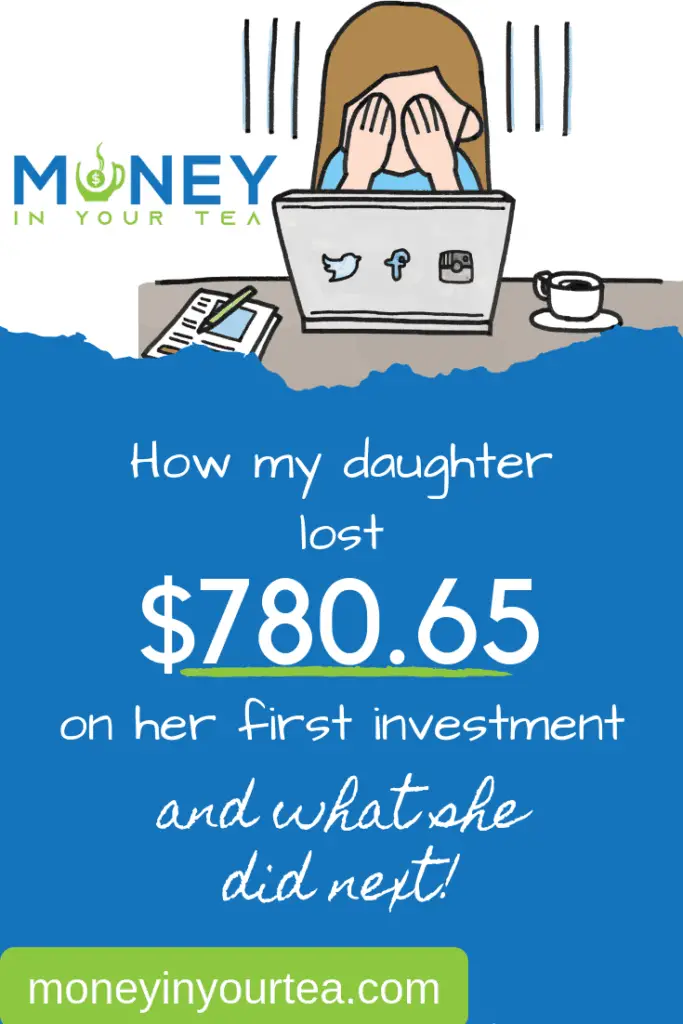My Gen Z daughter, Amber, opened a tax-free self-directed investment account (TFSA) last year and made her first investment. In Canada, people age 18 and older can open a Tax-Free Savings Account, or TFSA. That means that you can put money in this account and any income it earns is not taxed on your income taxes. Because you’re limited on the amount you can deposit each year, this type of account is best for money that you’re not going to need in the next year or more.
Amber’s Investing Goals
Amber opened a TFSA through BMO InvestorLine, a self-directed trading account. That means she can purchase stocks in a company, mutual funds, Exhange Traded Funds (ETFs), Guaranteed Investment Certificates (GICs), or simply leave it as cash.
If I lost you with the acronyms, it’s not really that important to the story.
In this account, which is intended for investing, leaving it as cash doesn’t pay any interest. So that’s not a good choice for her. A GIC would pay her some interest, but not a lot. These are funds that Amber won’t need for at least 5-10 years. Maybe she’ll use it to buy a condo someday, or maybe it’ll be the start of her retirement fund. The point is, she has a medium to long time horizon.
What did she Choose for her First Investment?
She transferred $5,500 from her bank account, the maximum TFSA contribution in 2018. Note that this year, 2019, the maximum TFSA contribution is $6,000. And any years you missed since you turned 18 can be made up later.
On September 21st 2018, she bought 210 shares of XIC, an ETF from iShares that tracks the Toronto stock market index. Okay, full disclosure, I not only advised her to buy it, I actually made the purchase myself because I have trading authority on her account.
This is what XIC looked like in 2018 up to that date:
The price of XIC fell early in the year, but it rose through the spring and stayed steady all summer. It seemed pretty safe, maybe the market correction some professionals were predicting wasn’t really going to happen. Maybe the drop last winter WAS the correction. It seemed like it would be just a steady investment for a while.
Then it all Went Wrong!
This is what happened between September 21st and Christmas:
Yikes! Amber had purchased her 210 shares at $25.70 each, and now they were worth $22.03. Including the $9.95 bank fee for making trades, I had lost my daughter $780.65 on her first investment! What kind of a parental financial advisor was I, to take her hard earned $5,500 and turn it into just over $4,700 in three months!

Needless to say, Amber was quite dismayed when she checked her account and saw there was substantially less now than what she put in. This was a painful lesson in the difference between investments where the principal is guaranteed, and speculative investing where you could end up with less. I was hoping that this experience with her first investment wouldn’t put her off investing permanently. Fortunately for me, she was busy with projects and exams and didn’t have much time to dwell on this.
On the other hand, I knew this was not the end of the story. Amber didn’t need that money anytime soon. If she did, we would have made a different investing decision. If she needed these funds for tuition or another short-term goal, it would have been appropriate to choose an investment with a guaranteed principal. Those funds are in her TFSA for the long haul.
Some might think it would have been better to invest a little each month rather than all at once. Then she could have bought some of those shares “on sale” when the price dropped. Read why this is generally not a good idea in How to Invest a Lump Sum.
Good News!
It’s now the spring of 2019, and the picture has turned around:
XIC, the iShares ETF investment that tracks the Toronto stock exchange, has really bounced back! As of today, it’s sitting at $26.44. That’s 74 cents per share above the price she paid. That’s a lot better than it was four months ago!
In addition, XIC pays out a quarterly dividend. In early January, it paid 14.81¢ per share, giving Amber an additional $30.11 in cash. At the end of March it paid out another $38.43 in dividends.
Between her investment and her cash, even after the bank fee for placing the trade, Amber has made $219.19 in 7 months. It’s not bad – nearly 4% – and the picture looks a whole lot rosier than it did in December.
What does the Future Hold for her First Investment?
The 5-year return on this ETF is 5.41%, and the quarterly dividend payments are on top of that. Of course past performance is certainly not a guarantee of future returns when it comes to investments. But maybe it’s the best we can go on. By the time she’s ready to think about buying a condo, in 5 years or more, that $5,500 first investment with the rocky beginning could be worth around $8,000. If she keeps it there until retirement, it may be worth over $65,000!

Take Away Message for You
When you have some extra funds, there are several things to consider. Primarily, when will you need this money? Secondly, what will you need the money for? Next, even if you don’t need the money right away, what is your risk tolerance? That is, how do you feel about seeing the value of that money go down in the short term? Think about that in dollar terms as well as percentage terms. How much do you know about investing choices? How can you balance a high return on your money with your personal tolerance for risk, in keeping with the time horizon until you need access to this money?
And lastly, if you don’t need the funds in the short term, try not to sweat if the money drops in value. In the long term, things generally go up.
Please note that I may hold shares in any investment that I discuss on this website.
Credit: Yahoo Finance for daily stock prices




